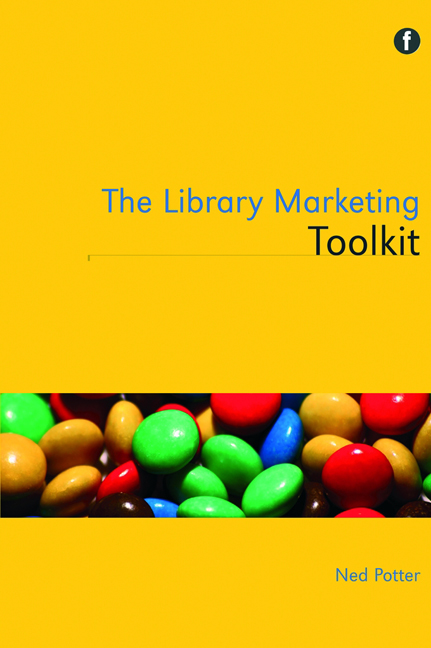Book contents
- Frontmatter
- Dedication
- Contents
- Acknowledgements
- Introduction
- 1 Seven key concepts for marketing libraries
- 2 Strategic marketing
- 3 The library brand
- 4 Marketing and the library building
- 5 An introduction to online marketing
- 6 Marketing with social media
- 7 Marketing with new technologies
- 8 Marketing and people
- 9 Internal marketing
- 10 Library advocacy as marketing
- 11 Marketing special collections and archives
- A final word on marketing libraries
- Appendix: Glossary of Web 2.0 tools and platforms
- References
- Index
- Frontmatter
- Dedication
- Contents
- Acknowledgements
- Introduction
- 1 Seven key concepts for marketing libraries
- 2 Strategic marketing
- 3 The library brand
- 4 Marketing and the library building
- 5 An introduction to online marketing
- 6 Marketing with social media
- 7 Marketing with new technologies
- 8 Marketing and people
- 9 Internal marketing
- 10 Library advocacy as marketing
- 11 Marketing special collections and archives
- A final word on marketing libraries
- Appendix: Glossary of Web 2.0 tools and platforms
- References
- Index
Summary
The world of marketing is changing more rapidly than ever before, and libraries are having to change with it. While some are still stubbornly refusing to engage with the need to market themselves, or are doing so using techniques that predate the digital age, for the most part the industry is responding positively to the challenges of promoting our services. The first part of this introduction is an exploration of what marketing really is and why libraries need to do it innovatively and successfully; the intention is that the remainder of the volume will provide the tools and knowledge to achieve this, with case studies from people who have been there and done it well.
If the bad news is that libraries are still not always great marketers, the good news is that marketing has never been easier! Today's platforms and tools make it more straightforward, more direct and much cheaper than it ever has been before. Little changes in the library approach can yield big results.
About marketing
What is marketing?
Formal definitions of marketing tend to be rather severe – and, because most marketing is about promoting the sale of as many items as possible for as much money as possible, widely quoted definitions are often slightly wide of the mark when it comes to libraries.
What marketing is not, is simply a poster featuring details of a new database. That's advertising. It's not simply an online campaign about a new service, either: that's promotion. It's not an article in the newspaper about the head librarian: that's publicity (and if the article is about the librarian welcoming a famous celebrity to the library, that's PR). And what marketing reallyis n't, although visiting many libraries across the world might make you think otherwise, is an A4 piece of coloured paper with a promotional message about new books printed on it in Comic Sans font.
What marketing is, then, is an ongoing conversation with your target audience, which combines promotion, publicity, PR and advertising in an organized, strategic way. In fact, in the age of Web 2.0, you can probably get away without any traditional advertising if necessary. But the promotion, the publicity and the PR exist amid a constantly renewing and neverending cycle of market research, planning, actions, followups and evaluation.
- Type
- Chapter
- Information
- The Library Marketing Toolkit , pp. xiii - xxiiPublisher: FacetPrint publication year: 2012



